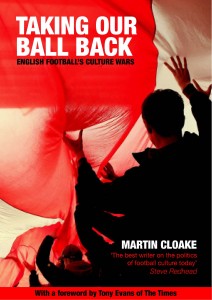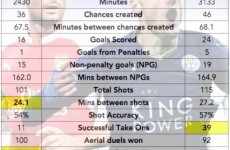*
In his latest book, ‘Taking Our Ball Back: English Football’s Culture Wars‘, MARTIN CLOAKE quotes political philosopher Michael Sandel’s statement that “The pleasure of sports has been diminished by its commerciality.” One of the central questions running through the collection of articles that make up the book is how the thing that makes sport so commercially valuable can be prevented from destroying what makes it so commercially valuable. It’s a complex discussion, but, as Cloake contends, one that has resonance beyond football.
.
3 September 2014
It is possible to trace a social, economic and political history of England alongside a history of its football clubs. And the current deep sense of discontent in the English game is rooted in this fact.
The roots of England’s football clubs lie in the efforts of church and factory to create community. Those who stood in the pulpit saw something that could provide a more wholesome outlet for the energies of the mass than drink and brawling. That mass of people had been brought together as never before by industry, and it is industry that looms large in English football’s formative years. The game’s early giants came from Blackburn, Preston, Burnley, Manchester, Sheffield, Birmingham, Bolton, Derby, Nottingham, Stoke, brought together by men connected with steel, railways, textiles, manufacturing.
The world’s first Industrial Revolution shaped England, and England’s sport. Community is at the core of football, and with it notions of identity and place.
As the country changed, so did football. As the heavy industrial age petered out, affecting the fortunes of the early northern giants, the suburbs began to rise in the south. London, of course, had its industrial clubs, West Ham from the Thames Ironworks, Millwall from the docks, Arsenal from the munitions plant in Woolwich. But there was also Fulham, formed by a schoolteacher and churchmaster; Chelsea, established by a businessman who wanted to utilise a stadium; and Tottenham Hotspur, formed by a group of middle class boys under the watchful eye of a Bible teacher from a local church.
These were teams that rose to represent the south and the suburbs, the new world. When Tottenham Hotspur took on Sheffield United in the 1901 FA Cup final, 110,000 went to Crystal Palace Park in south east London to see the Flower of the South against the established might of the north. A turning point in football on the turn of the century itself.
Now, the Premier League is the richest and most glamorous in the world, English football is an in-demand global brand. But while it attracts support it does not inspire love. Love the game, hate the business; love the team, hate the club. The phrases fall readily from the lips of fans struggling with the contradictions that define them as football supporters. So too does the word ‘meaning’.
Football is successful commercially because it means something. The trouble is, we’re not sure what any more.
For many fans at many English clubs, it seems increasingly as if they support an idea that ceased to exist some time ago, a name that once meant something but is now just a badge sitting atop a global corporation or, most recently, a foreign government’s public relations spin. Those who own and administrate are also confused. The money is rolling in, facilities are better … hell, there are even toilets for men AND women at grounds, so modern and customer-orientated has the game become. And yet there is still discontent. Why, they wonder, can the fans not be happy?
It’s becoming fashionable to say, especially of football, that business is ruining sport. It’s the language that irritates the most, turning fans into customers, games into matchday experiences and throwing up job titles such as Head of Fan Relationship Management. Someone who held that very post at Manchester City, Claudio Borges, caused much hoo-ha last year by saying of the fans that his job was to “engage them, serve them and monetise them”. He quickly had to replace “monetise” with “provide fans with relevant commercial opportunities”.
Writing about the incident in The Independent, journalist Michael Calvin aired his displeasure with the way things were going, talking of “Big Brother” “robo-marketers” and the battle between “idealists and monetisers”. I have a lot of sympathy with those reactions. But I’m wary of a hairshirtist tendency that says commercialism is the cancer at the heart of sport.
If you’re going to pay people to play sport, you introduce an element of commercialism. It was the growth of paid professionalism that swept unpaid amateurism aside and opened sport up for mass participation. In Matt and Martin Rogan’s book Britain and the Olympic Games, the authors write of efforts to “preserve sports club membership for the social elite. Those who competed for wages were excluded … In this sense amateurism was initially nothing more than a convenient way of preserving sport for the elite.”
This apparent clash between a yearning for a more Corinthian approach and a distaste for the vulgarity that commerce has inflicted upon sport is central to any effort to make sense of modern sport. I went to speak to Matt, who is now MD of Two Circles, a customer relationship company that uses data to “help sporting organisations get closer to their customers”. It’s the kind of description that may already have caused some hackles to rise, but I know from working alongside Matt that he has a genuine passion for sport and a keen understanding of where the commercial element fits in.
He starts off by pointing out that the most visible sports represent “a small percentage of the sport actually played in this country. Football, for example, only accounts for just over 10 per cent of the 15 million people in this country who play sport every week,’’ he says. “With sport, once it becomes a business, just like any business you get some that are well run and in it for the long term, and some that are not,” he says. “Remaining successful has to be about having a sustained customer base that cares about what you do.”
Creating that base involves nothing more complicated, he says, than “finding out what your customers want and giving it to them. When you look at the long tail of participation sports in this country, the business of sport is fundamental to them creating a sustainable operation. Government funds simply won’t allow survival by subsidy, so they have to no option but to think differently”.
He talks about the success of Harlequins rugby union club, where community outreach (junior teams are coached on Saturday mornings and invited to stay on for the match) and taking on board what supporters think has created one of the fastest-growing supporter bases in the country. Harlequins gather feedback after every match, and fan satisfaction is consistently the highest he has ever seen.
At Reading FC, the number of season ticket holders increased after the club was relegated two seasons ago, again through genuine community engagement. In cricket, ’Last Man Stands’, an 8-a-side 20-over league in urban areas run on weekday evenings, is bringing new people into the game, in particular ethnic minorities. In a much-publicised step a customer survey drove the creation of the County fixture list a few seasons back.
While sports need to stand on their old two feet financially, that doesn’t always mean the fan pays the bill. Triathlon England – which has seen huge growth in participation, having almost tripled its membership – works with local authorities to get the high cost of entry down by arranging bike loans or splitting entry fees with local sports centres. Cycling’s success has come on the back not just of high-profile success but because a large commercial partner – Sky – “enables the sport to have the funding to develop programmes that are right for different kinds of customers” such as women’s cycling programme ‘Breeze’ and school cycling proficiency schemes.
The idea of creating a sustainable base runs through all these examples, and this is where the drivers of the business and the sporting institution come together, reckons Rogan. One of the most striking things he says is that: “Sponsors have been disenfranchised by clubs and sports that don’t have a true, empathetic, warm relationship with their customers.” He goes on: “Any sporting organisation right now that doesn’t put customers at the heart of its sponsorship proposition is in real danger. Big brands are finally realising it’s incongruous to spend most of their time and budget getting closer to customers and then take a sponsorship and say ‘just a logo and some pricey hospitality for us thanks’. Sports fans can see that a mile off. Budweiser missed a trick at the FA Cup Final [in 2013] not transporting fans from Wigan back home from Wembley, when the kick off-time meant they could not get home by train.”
He recognises football is a special case, not just because of the popularity of the top clubs, but also because of the way it’s run. The Premier League is there to return money to its member clubs, so doesn’t necessarily have the relationship with the grass roots that, say, the England and Wales Cricket Board does. And, he says: “The way any business is run is a lot to do with how it’s owned. You’ll get a business that’s under private equity ownership that’s driven hard for short-term profits and a lot of the time you’ll find the care for employees and the push for long-term foundations isn’t necessarily there.”
He is eager to point out there are some examples of good practice – even in what may seem the unlikeliest of places. “Notwithstanding the enormous loss Manchester City made in the first year of the current ownership, I’ve got a lot of respect for the way they have gone about thinking about the growth and ongoing development of their club. The first things they did weren’t about customer revenue, but about customer relationships. So they put a large infrastructure around the stadium that just sold beer in a way that was quick and easy and made it easy for fans to meet before the game. They developed a membership proposition that was just about rewarding loyalty, and the basic level of that was free. They did a lot of smart things that weren’t about revenue growth but about creating the sort of links with supporters that Manchester City hasn’t had for 20 years.”
He thinks many football clubs need to think smarter about ticket prices, for example, returning to the relationship with sponsors to illustrate his point. “You can create a more sustainable revenue line by giving people what they want rather than imposing blanket price rises,” he says.
Putting £30 on every ticket will provide more short-term profit than devising a meaningful membership package for kids that creates a more sustainable base long term, but that doesn’t mean it’s the right thing to do. Creating a unique package that sponsors really want and charging them an extra £100 per seat could please both sponsor and bank manager, and subsidise the kids’ seats. “You have to understand the long-term benefit,” he says.
He reckons sport “needs to be more confident about what it has to offer”, but says “that confidence can’t be built on sand. Some of the organisations we work with have millions of people engaging with them and loving them month in, month out. Generically telling that to a business just sounds like a sales pitch. Providing evidence of that to a business changes the view of what sport can offer.”
You could dismiss Rogan’s comments as yet more “robo-marketing”. But you would be wrong. For it’s not the business of sport itself that is the problem, but the way the business is often conducted. Whether you call it listening to the fans or building a sustained customer base, it all comes down to giving the fans what they want. The trouble with too many in football is that they are telling the fans what they want – that’s when they bother to communicate properly with them at all. If we want to change the direction the game is taking, we may need to ask not what the business of sport does to us, but what it can do for us.
This article is an edited extract from Martin’s book Taking Our Ball Back: English Football’s Culture Wars, available now. It features material first published in Thin White Line magazine and at New Statesman online. More from Martin Cloake on his blog: www.blog.martincloake.com; website: www.martincloake.com; Twitter: @MartinCloake
.










